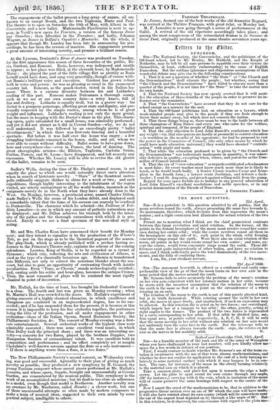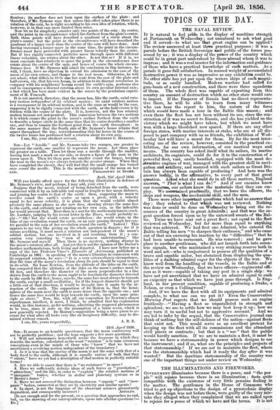Oxford and Cambridge Club, 15th April.
Sin—As a humble member of the rank and file of the army of Wranglers whomyron have challenged in your last number, will you kindly allow me space for a few words in defence of our position. First, I would venture to doubt whether Mr. Symons's use of the term ro- tation is coextensive with the use of that term among mathematicians, and whether he does not confine its application to the case of a body turning re- latively_to some material surface with which it may happen to be in con- tact. The case, for instance, of the moon in the-orrery turning relatively to the material axis on which it is placed. Take a common plate, and place flat upon it towards the edge a half- crown-. Let the plate be spun round its own centre through any angle, (90' for instance,) carrying with it the coin, which in imitation of the-moon will of course preserve the same bearings with respect to the centre of the plate. Now I assert the creed of the mathematician to be that in addition to the progressive linear motion over an are of 90° which the coin will have made, • it will also have rotated about its own centre (Which willlie somewhere near the-ear of the august head depicted on it) through a like angle of 90'. But in this rotation, be it observed, the coin remains with regard to the plate nio- tionless ; its surface does not turn upon the surface of the plate : and therefore, if Mr. Symons says that unless this effect takes place there is no rotation of the coin, he is right according to his own idea of rotation, which, however, is in that case more limited than mine. Now let us for simplicity- consider only two points of the coin : its centre, and the point in its circumference which lies furthest from the plate's centre. Both these points will have described a quadrant of a circle about the plate's centre : but the point in the circumference will have described the quadrant of a larger circle than the centre of the coin will have done. And having traversed a longer space in the same time, the point in the circum- ference must have proceeded with greater linear velocity than the centre. But if two rigidly connected particles move through space with different linear velocities, one rotates about the other. Is not this so ? If it is, we must conclude that relatively to space the point in the circumference does rotate about the centre of the coin, and hence of course the whole circum- ference does. If Mr. Symons will admit the conclusion in this instance, he will, I think, have no objection to extend his admission to the case of the moon of his own orrery, and thence to the real moon. Otherwise, he will not admit, what differs in little else but scale from the case of the plate and half-crown,. viz. that his own house, in addition to its diurnal revolution in company with his neighbours' houses round the earth's axis, .performs also and in consequence a diurnal rotation about its own peculiar internal axis; a fact which has been made evident to the senses by the pendulum experi- ment of M. Foucault.
It is not asserted, therefore, that the moon has, like the earth, axial rota- tory motion independent of its orbitual motion ; its axial rotatory motion is a consequence of its orbitual motion, and is the same as' would be the ease, supposing it to be rigidly connected with the earth, as the ball-crown is by friction with the centre of the plate. It is, however, not the less rotatory motion because not independent. This connexion between the two motions it is which causes the point in the moon's surface furthest from the earth to describe a larger circle in the same time that its centre describes a smaller one, and thus to remain the furthest point from the earth throughout : in the same manner that the South side of Mr. Symons's house retains that aspect throughout the day, notwithstanding that his house in the course of the twelve hours has performed half a rotation about its own axis.



























 Previous page
Previous page